
tricky tracks on the right.
(Photo © J. Maus)
This week, the City of Portland Bureau of Transportation decided to remove on-street parking on the new transit mall ahead of schedule due to safety concerns first brought to their attention by the Bicycle Transportation Alliance (BTA) back in October.
Concerned about the dangers posed by cars parked in the auto/bike travel lane, BTA advocate Michelle Poyourow called a meeting with TriMet and PBOT’s transit mall project manager Teresa Boyle to discuss the issue. In that October meeting, Poyourow expressed her concerns and urged TriMet and PBOT representatives to “remove parked cars from the travel lane immediately” and to not wait until the scheduled March 1st date.
“I just wish they would have gotten to the decision faster to save a few more people from crashing, but I know it was a hard decision to make.”
–Michelle Poyourow, BTA
Poyourow’s sense of urgency was spurred by a growing number of reports from riders who had crashed on light rail tracks on SW 5th and 6th Avenues in part due to being forced into the tracks to avoid parked cars.
One of those riders was Jan Schaeffer. Schaeffer, who works on SW 6th Avenue, crashed on the tracks between SW Taylor and SW Yamhill back in December when, as she puts it, she was forced to “weave into the trackway” because a parked car “plugged the lane”. (Coincidentally, Schaeffer was the City’s bike and pedestrian program manager. A post she held from 1977-1984).
In an email to me about her crash, Schaeffer wrote;
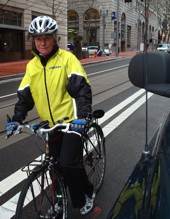
she got “squished” on SW 6th.
(Photo courtesy J. Schaeffer)
“I am a veteran bike commuter. I pay close attention to tracks. Until I crashed I assumed only novices fell victim to parallel tracks but I’ve learned that the conventional wisdom is wrong.”
Schaeffer said the problem is rampant. “There are at least three others in my office who have crashed,” she wrote,
“A man working in my building has a pin in his ankle. Several smokers who witnessed my crash said they’d seen several others fall.”
Luckily, Schaeffer didn’t sustain major injuries, but others have.
Another rider, who asked to remain anonymous, broke a rib and severely injured his collarbone in a crash on the tracks on SW 6th last August. He contacted BikePortland.org via email and wrote:
“I think that the new bike path that runs along the left is o.k., but it freaks me out that the cars are there.”
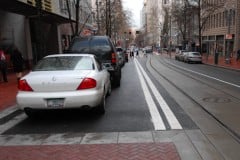
be free of parked cars.
(Photo © J. Maus)
With cars parked in the left lane (trains and buses operate on the right), bike riders are forced to occupy a narrow piece of road that sometimes comes withing a few feet of the rail tracks. (Once the mall project is completed, the left lane will be reserved for bike and auto traffic only and the parking will be removed, but the streets are currently open and are being used by bikes and cars already. Parking has already been removed on some portions of the mall due to bus training.)
At a follow-up meeting with PBOT project manager Teresa Boyle at the end of November, Poyourow thought she had made progress. “They said they would remove the parking at the end of the holidays…the first week in January instead of the first week in March.”
But after that meeting, Poyourow claims that Boyle made it clear to her that the parking removal couldn’t happen in that timeframe because three months of lost parking meter revenue would cost the City an estimated $55,000*.
Poyourow said her response to this was that the situation was already costing the city more than $55,000 in medical bills from crash victims, a sentiment echoed by Jan Schaeffer: “The city may be collecting $55,000 from parked cars, but we injured could easily be shelling out a similar amount.
When I reached Boyle to ask about the situation, she admitted that the parking meter revenue was indeed part of the decision to keep the parking. “That is a factor, yes,” she said,
“it’s revenue to us…we lost over 100 on-street spaces when the busses moved off the mall and onto 3rd and 4th and this (spaces on 5th and 6th) was an attempt to replace that inventory.”
Beyond simply a matter of lost revenue, Boyle says the parking issue has “been a balancing act the whole way,” and that much of the issue comes down to scheduling and availability of their maintenance crews.
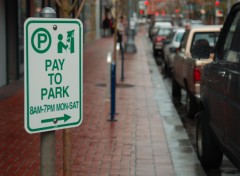
all signs and meters gone by the
end of this month.
(Photo © J. Maus)
The Bureau of Maintenance (BOM) is needed to remove the parking meters and signage. Boyle says this issue is more about BOM crew availability (especially in light of our major storm) than lost revenue. I asked Boyle if it’s typical for BOM scheduling to influence policy decisions.
Why couldn’t PBOT just issue a memo and put up signs over the meters saying that parking was no longer allowed?
Boyle replied:
“To completely strip all of the parking from the lanes really makes it that much more difficult for our contractor to guarantee that those lanes would stay open. My preference was to do this in a way that moves the project forward without a hiccup.”
During my research on this story, I received word from Poyourow that PBOT decided to hasten their parking removal schedule. I confirmed this with Boyle who said,
“The good news is that we’ve confirmed with BOM that they will have it all removed by end of January. Barring unforeseen dumps of snow, (in which case BOM crews would have to respond) we’ll start seeing it come off next week.”
Boyle said their decision was in response to “the conversations we’ve been having about cyclists” with Michelle Poyourow.
Poyourow sees this as a unfortunate symptom of a “really starved transportation system”. When I spoke to her today from the BTA offices in Northwest Portland, she said she’s encouraged that PBOT acknowledged the problem and that it’s “good precedent” for them to weigh health and safety against revenue and schedules.
“I’m glad they ultimately made the right call,” she explained, “I just wish they would have gotten to the decision faster to save a few more people from crashing, but I know it was a hard decision to make.”
*According to PBOT parking officials, the $55,000 in lost parking meter revenue is an estimate based on average per space dollar amount, rather than a maximum rate (so the meter loss could actually be much greater). Sources for this story said SW 5th and 6th Avenues have a very high meter occupancy rate and that their are few empty meters to go to if meters are removed (therefore, people would use off-street private lots or garages — meaning lost revenue to the city.)
— Learn more about the new transit mall at PortlandMall.org.


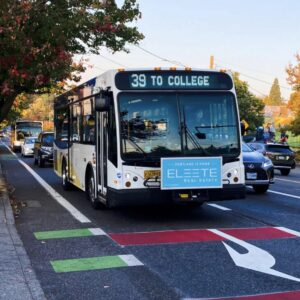
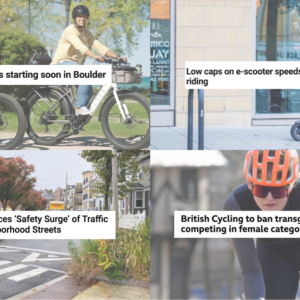
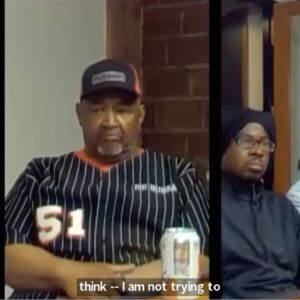
Thanks for reading.
BikePortland has served this community with independent community journalism since 2005. We rely on subscriptions from readers like you to survive. Your financial support is vital in keeping this valuable resource alive and well.
Please subscribe today to strengthen and expand our work.
I rode this stretch (with Michelle, actually) just the other day and it was terrifying. I’m glad they’re doing something about it, but I’ll be avoiding it until they get the parking out. I’d rather be leapfrogging buses on 3rd & 4th than ride the gantlet between tracks and doors. Talk about a rock and a hard place.
Thanks to Michelle for dogging the issue; I’m confident nothing would have happened without her diligence.
Okay, this is silly. If they wanted to close parking on that side of the street, they could have sent an e-mail to the shift list, or the bicycle count volunteers, or to bikeportland or whatever, asked for volunteers to go down the block and put no parking bags over the parking signs. Assuming they have the bags already printed, (and I imagine the city has a warehouse of them,) it would take about 5 minutes to send an e-mail, and then having people stop by to pick up bags at the person’s office. The signs would be bagged and the lane would be clear in a couple of hours.
I ride down 6th every day, and I can think of a couple of things people can do to avoid crashing on the tracks between now and March 1:
#1 Do what I do: ride your bike as close to the white lane marker as possible. I’m far enough away from parked cars that I feel comfortable and plenty far enough away from the tracks that I don’t have any fear of getting caught in them.
#2 Ride on another street. 4th avenue is also downhill, and it’s totally safe because you can ride–with little effort–at the same rate of speed as traffic. With buses on this street I recommend taking the left lane. Heading the other way, I’d take Broadway because the bike lane makes it easy to move faster than traffic (during rush hour, when traffic crawls).
Frankly, I think the city can use the money that those meters generate, so I hope they keep them as long as possible. With the economy the way it is, I’d rather suffer through a few (avoidable) accidents. I know I’ll feel like an idiot if I crash, and after my recovery I’ll probably just end up taking 4th and 3rd (or Broadway) instead.
Wait, the city is paying people’s medical bills?
“asked for volunteers to go down the block and put no parking bags over the parking signs.”
Sorry for the double post, but I don’t think the union would like that very much.
Now once the parked cars are gone, let’s take these two streets over…bikes, bikes, bikes, bikes up and down the Mall, merrily, merrily, merrily, merrily, no one takes a fall.
sorry.
@Matthew Denton
Your train of thought is logical and would be effective if it could be done. GLV hit it earlier – the union would never allow the community, or volunteers to do the work you suggested.
A coworker of mine caught her front tire in one of those tracks and went over her handlebars. She sprained her wrist, got some huge black bruises, and missed several days of work. :^(
I crashed on the tracks on 5th right after Thanksgiving. It only take a moment of inattention and I’m an experienced rider. The guy who helped me up said he’d seen the same thing 3 times that same day, though I have no way to substantiate that.
My whole hand was swollen up for a week and it’s still stiff and sore. Luckily no break.
The whole design is bad. Bikes should not be using the mall at all, solely based on this bad design. I’m talking about strictly based on existing conditions, not what’s right and wrong. Just stay off the mall, for your own safety.
@9 That’s not really feasible since some of us use our bikes for work and are kinda required to use both 5th and 6th to get around to certain areas. I usually will take other routes if possible but alot of my delivery locations are actually on those roads. I agree that for alot of locations there are alternative routes but these are the most direct. I have only gone down one, because a car cut be off ( barely, almost hit me is more accurate while he was making a right onto 5th at a redlight) anyway I swerved to avoid the car and got my back tire caught ( managed to keep my front out so I didn’t actually wreck) it did jack up my back tire though.Even after getting it trued it is still a little wobbly feeling. 🙁
Just my 2 Cents,
Randy
6th is the straightest shot off the hill from OHSU, and while I try to get off 6th as soon as possible and cut over to the waterfront, I’m still following the tracks for a few blocks.
do what i do and ride with both tires in the tracks. this way there is no danger in catching a tire when crossing them. hands free steering is an added bonus.
Can someone ask the city to post the data on their math. 55k seems way to high. And even if it is true this proves that there is high demand for car parking. The city should charge more per hour to cars who park rather than risk the death of someone on a bike. Jeees US H cripes.
The city should tax parked cars for the burden they put on the city. I’d love to know how much city owned land is leased or used in any capacity for car parking.
The city should start charging for street parking at night. That will do two things – 1) gain more revenue for transportation system maintenance which is sorely needed and 2) make parking downtown more simple so that drivers aren’t encouraged to spend 15 minutes circling blocks for a free parking space. If street parking is cheaper than private lots, then there will always be this imbalance.. The city should charge market-rate.. Plain and simple.
There are so many good ideas posted by the readers on this website. For example: I’m guilty of the crime just mentioned: I waste gas by circling downtown looking for the lower rate curb side city run parking.
All meters should charge a bit more than the nearby garages? Why? Well at PDX they installed those fancy green lights in the parking lot. Why? To save the earth by saving gas and reducing tail pipe outlet. No circling PDX airport parking. There is also less stress for the driver who does not fear the grass is greener. The same goes for downtown, reduce circling for parking.
And downtown there is much more risk that circling for parking will cause an accident.
With market rate parking car drivers will have reduced mental stress. They know the fee is one level playing field. No greener grass.
So if you remove the parking, don’t the cars just park somewhere else? Is it really a one for one loss of revenue?
What am I missing?
I wiped out on tracks in November. (Not on the mall, on NE 2nd old streetcar tracks.) I’m STILL recovering. So I say hurrah for doing something to keep people’s wheels away from tracks. I had always thought anyone who whined about tracks was a big baby and didn’t know how to ride around them until I wiped out. Stay off the tracks when you can, people.
I ride out of downtown on 5th every day; and until the left lane is cleared of parked cars I’ll continue to ride in between the tracks. There’s less traffic there, and I don’t worry about getting my tires stuck!
The city should raise the fees for parking and make them the same across all of downtown. I highly doubt there would be a drop in the number of cars parking downtown. Revenue is not the main reason for cities to charge for parking, rather it’s to deter unecessary parking and to encourage mass transit use. Even with an effective mass transit system and a high cycling population, Portland is still far from suffering a shortage of drivers wanting to park downtown. So raise the fees across the downtonw area, raise them enough to cover the alleged 55K shortfall and then some, enough to cover the labor of removing the parking strips and what not.
I still think the downtown mall route should be for trimet and bikes only. I know the hotels and others fought heavily to maintain automobile access to it. So now that these streets are going to be reduced to a single lane for cars and bikes, if we bikers use them so much that motorists will find traveling down 5th and 6th too cumbersome, there will be a chance to officially declare them as pedestrian, bikes, and trimet only streets. Imagine that, quasi-bike boulevards down the middle of downtown.
I was walking down 5th ave (I think – maybe it was 6th) on Thursday and noticed that the parking on that block (1 or 2 blocks south of Alder) was not even pay parking – it was marked as 2 hour free parking. I’m guessing this isn’t true for the most of the area, but couldn’t they at least pull the parking for the blocks where people aren’t even paying?
@16 Yes they will park someplace else, but possibly in a private lot or garage.
As for the $55,000 in lost revenue over 3 months, here is the math. I’d like to thank Google Earth in advance for their help 🙂
$1.25/hour for 11 hours a day (8am-7pm) =$13.75/day per parking space.
x 9 parking spots per block face
x 50 (roughly 25 blocks on each 5th and 6th b/w I-405 to the south and the train station to the north)
x 6 metered days in a week
x 4.3 weeks in a month (average)
x 3 months
or =((((((1.25*11)*9)*50)*6)*4.3)*3)
= $478,912.5.
I’m not sure what the city’s take is and I’m sure there are some flaws in my assumptions but $55,000 in lost revenue doesn’t seem unreasonable.
I do like the idea of charging on Sundays, etc. Even though I would have to pay when I drive downtown on those days with my whole family.
As for bagging the meters, its been said but the union would be one problem the other is that it sounds from the article like they have a specific maintenance contractor for the the transit mall who might also object.
Raising the rates to $1.50 an hour would solve the problem.
And take back some of the liberally over-appropriated parking spaces that are given carte blanche to construction companies.
Problem solved.
the same BS went on when the central city streetcar was under construction, the rails were laid, but parking was still allowed at places along the line before the trains started running that created hazards for cyclists, which the city did absolutely nothing to mitigate.
Parking >> Cycling as far as the city is concerned, this hasn’t changed in the 20+ years that I’ve lived in PDX.
BURR…and it isn’t going to.
Why is that? the city doesn’t cater solely to cyclists…no matter how much y’all would want them to.
I drove down the mall this weekend…even driving through that stretch is a nightmare…so it becomes a road I will NEVER ride on.
Catering solely to cyclists and considering them when doing street planning are hardly the same thing, bahueh. But this sort of hysterical hyperbole is a good example of your anti-bike bias.